 These open-ended pipe piles, about 100-feet long and two feet in diameter, will be used to test a type of bridge pile often seen in offshore applications, research that could help reduce the cost of bridge building or replacement of aging spans. Purdue University photo/Erin Easterling)
These open-ended pipe piles, about 100-feet long and two feet in diameter, will be used to test a type of bridge pile often seen in offshore applications, research that could help reduce the cost of bridge building or replacement of aging spans. Purdue University photo/Erin Easterling)Rod Salgado, a Civil Engineering professor and researcher at Purdue, is working on an open-ended pipe pile to replace the typical rounded pipe, for use in the construction of bridges, wlfi.com reports. The research comes in response to the Indiana Department of Transportation’s (INDOT) and the city of Purdue’s decision to replace the eastbound bridge over the Wabash River, which has an unusual type of soil.
“INDOT hasn’t really used these larger diameter pipe piles,” Salgado told the news agency. “Piles this large are common in the offshore industry. You build oil production platforms and things like that.”
Salgado told the news agency that the soil where the bridge is being constructed has a lot of gravel and cobble, so a rounded pipe pile would be difficult to use.
“You can drive them into the ground more easily than a pile with a closed tip,” Salgado told the news agency. “The issue is that when you go to design them, try to figure out how much load they can take, the fact that they are open-ended created complexities.”
Salgado and his team are testing to see how much force the piles can take. “We are load testing these piles,” he told the news agency. “So, that means we are applying load on these piles against a reaction frame, and we are studying how the piles respond to the loading as you increase the load.”
Salgado told the news agency that the technique has been used in a few projects around the country, but he is hoping the results from his research of the Wabash Bridge construction will start a new trend. He said the technique is the most economical solution for that particular project, but that it is on a case-by-case basis right now.
“There aren’t a lot. I think that may be because we don’t yet have the methods to estimate the loads as accurate as we would like,” Salgado told the news agency. “As we understand that better, I think the use might go up significantly.”









